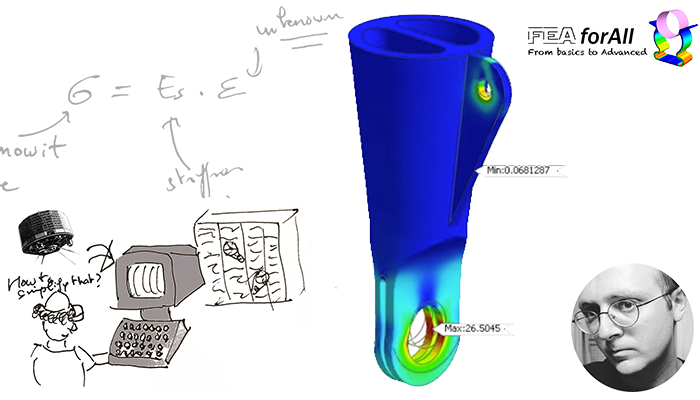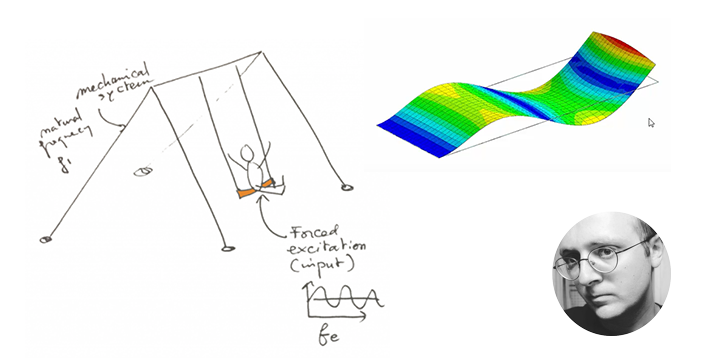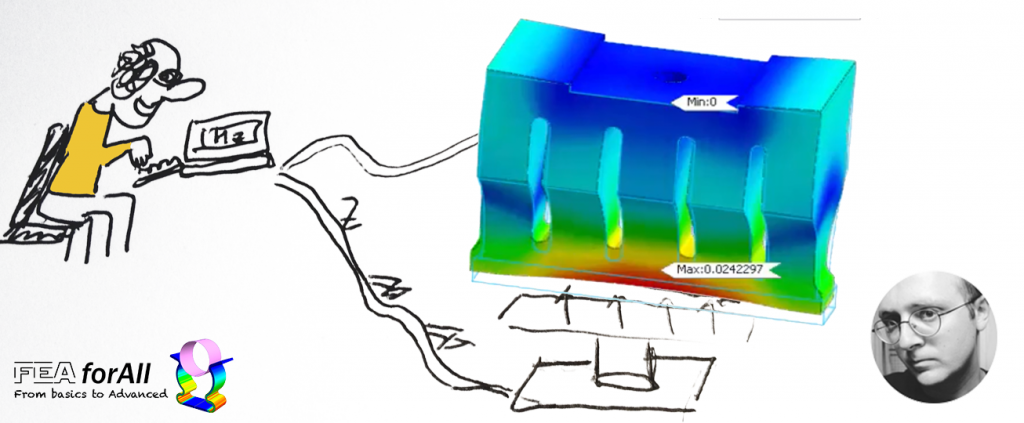Today, I decided to make a video to talk about a topic for which I received a lot of questions:
Why is there so many fea analysis types?
Why is there linear static? nonlinear analysis? dynamic analysis?
It is something very confusing for beginners in FEA analysis.
It was the same for me when I started doing FEA…
I just wanted to open the software, import a model, applied load and then get stresses by clicking on one button…
But it was never so simple ;-)
Especially that one of the first choice I had to do was the type of analysis.
I didn’t understand in so much details what linear static analysis was all about… and I understood even less about nonlinear or dynamic analysis.
So…what is the difference between those analysis? And why do you even have different types of analysis?
As engineers, we would like to be able to simulate everything around us to understand how things work, and this is something totally normal!
What is important to understand though is that he world is always more complex that it seems to be…
SO even if we would like to do the simulation process in just a few clicks, there are a lot of assumptions that we have to do before getting any kind of results.
One of the major assumption we have to do from the start concerns the type of analysis we will run.
The first type of FEA analysis: linear static analysis
In fact, our world is nonlinear and dynamic by nature and there is no such thing like linearity in nature…
Linearity is something that has been invented by men to simplify some of the interactions so we are able to describe them better.
What does linearity means?
well, basically, it means that if you apply a load of 10 N and you get a response of XX MPA, then if you apply a load of 100N, you will get a response of 10*XX MPa.
It means that there is a proportionality relation between the load applied and the stress response.
This type of linear analysis is in fact a big simplification of reality
And what does static means?
Static relates to the time component of the analysis.
It is the inverse of dynamic…
So it means simply that an analysis that is static takes the assumption that your system doesn’t depend on time.
Most of the phenomena we observe every day are actually dynamic rather than static.
If an object fall on the group, it’s dynamic…
Applying a load is also something dynamic, so when you do the assumption that something is static, it means that you are doing the assumption that the load you apply on the object is applied infinitely slowly… so slow that you can say that the inherent dynamic properties of the load application becomes negligible.
Now you know what linear static analysis means !
It’s the most common type of analysis because it is also the most simple analysis.
The algorithm the solver uses to solve such an analysis is also quite simple and can be resumed to a simple matrix computation.
If you are interested to learn a bit more in details about linear static, I wrote another article recently about it here:

Article to read: What is linear static fea analysis?
Now the second most common type of analysis you will hear often about is modal analysis.
The 2nd type of FEA analysis: Modal Analysis
Modal analysis is a study of the fundamental vibration modes of an object or system.
Every object or system is vibrating in reality.
When you apply a forced vibration to your system in a certain direction for example, you will observe that it will start to vibrate inside in a certain way ad at certain specific frequencies called « natural vibration frequencies ».
When the forced vibration applied to the system vibrates at the same frequency than the system’s natural frequency, a phenomenon called « resonance » takes place and the deformations that were very small at the beginning start to grow exponentially… leading sometimes to the failure of the system
You can imagine a car on the road for example.
The motor of the car vibrates in function of the speed of the car and the state of the road.
Sometimes, when you are at a certain specific speed and you keep this exact speed, you will notice that you car will start to vibrate much more… that’s it (it depends of course how your car was designed ;-) )
By doing modal analysis, you are actually able to find those vibration frequencies of your system, which allows you eventually to re-design your system accordingly to avoid those critical frequencies.
If you want to learn more about modal analysis, you should read this detailed article on my blog:

Article to read: What is modal fea analysis?
Now… modal analysis only gives you the frequencies, it doesn’t tell you how much your system will resonate if it enters in resonance.
To know that, you will have to do a more advanced analysis called « frequency response analysis »
Here’s an article about frequency response analysis:

Article to read: What is frequency response analysis in FEA
What about other types of analysis?
There are many other types of analysis that you will need to understand… for example nonlinear analysis, thermal analysis, optimization …
Here are related articles that you may want to read:
Thermal analysis:
http://feaforall.com/heat-transfer/
Topology optimization:
http://feaforall.com/reduce-cad-design-cost-using-simulation/
//////////////////////////////////////////////////////////////////
I really want to contribute and help engineers (and students) who are new to FEA to understand basic concepts better and faster!
I am not hiding that it takes a lot of efforts to record this video and write all that, so…
If you like this article, there are 3 things you can do for me:
1- Help me to share this article on Linkedin, facebook, twitter or in your habitual forum to help more people understand those basic concepts better.
2- Let me know in the comments what you learned from it and what you would like to learn even further so I can write more on the topic.
3- Join the newsletter and I’ll send you everything I write (and much more) by email!
Thank you for reading!
–Cyprien
Cyprien,
Thanks – great starting point for beginners…
Great artcile for students and beginners
Write some informations about CFD & CFX analysis.
Thanks Cyprien,
I would like to hear more
Thanks,
interesting article and well resumed. l like it. go ahead Cyprien
Thanks,
It helped me to understand basics of it. Very good article
Thank you!
It is very important article for beginners.
I Like it , this is very interesting topic to know all the basics of FE analysis
Great article, Cyprien. What about things like: pushover, transient, discrete?
thank you very much. it seems like the video is made for a beginner like me.
Thank you so much for the contributions!
I have started to watch as many tutorials as I can in order to be more knowledgable in this field so I can get a Job as a FEA engineer
You’re welcome Jacob, glad to have you one the blog!
Don’t hesitate to ask questions :-)